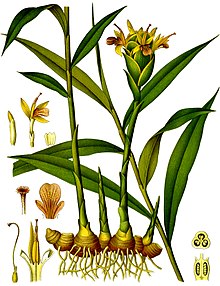| Zingiber | |
|---|---|

| |
| Zingiber officinale 1896 illustration[1] | |
| Scientific classification | |
| Kingdom: | Plantae |
| Clade: | Tracheophytes |
| Clade: | Angiosperms |
| Clade: | Monocots |
| Clade: | Commelinids |
| Order: | Zingiberales |
| Family: | Zingiberaceae |
| Subfamily: | Zingiberoideae |
| Tribe: | Zingibereae |
| Genus: | Zingiber Mill., 1754 |
| Synonyms[2] | |
| |
Zingiber is a genus of flowering plants in the family Zingiberaceae. It is native to Southeast Asia, especially in Thailand, China, the Indian Subcontinent, and New Guinea.[2][3][4][5] It contains the true gingers, plants grown the world over for their culinary value. The most well known species are Z. officinale and Z. mioga, two garden gingers.
- ^ Franz Eugen Köhler, Köhler's Medizinal-Pflanzen
- ^ a b Kew World Checklist of Selected Plant Families
- ^ Flora of China v 24 p 323, 姜属 jiang shu, Zingiber Miller, Gard. Dict. Abr., ed. 4. vol. 3. 1754.
- ^ Govaerts, R. (2004). World Checklist of Monocotyledons Database in ACCESS: 1-54382. The Board of Trustees of the Royal Botanic Gardens, Kew.
- ^ Tripathi, S. & Singh, K.K. (2006). Taxonomic revision of the genus Zingiber Boehm. in North-East India. Journal of Economic and Taxonomic Botany 30: 520–532.